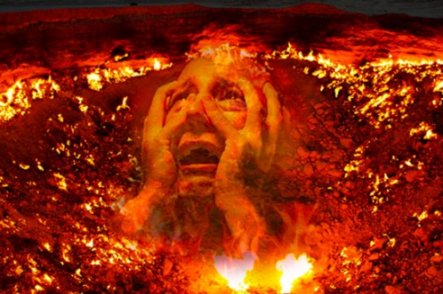
People are rightly concerned when it comes to the doctrine of hell because so much is at stake. What happens to people after death? Is hell for ever, temporary, or is there is no such place at all? Is it just the 'grave'? Is anyone even conscious after death? What does our belief about hell tell us about the character of Elohim (God)? These are some of the questions that Bible students have asked themselves over the centuries in their bid to understand the Scriptures on this obviously important subject.
Understanding biblical terminology becomes essential as this is a complex subject. To begin with, the English word 'hell' is not a biblical one but has been borrowed from the name and mytholigical residence of the pagan Teutonic deity called Hele, the goddness of the underworld 'hell' of northern Europe. That is a good reason for turning to the biblical words, of which there are four in particular that are important to correctly grasp - misunderstanding (and therefore misapplying them) has led to many distortions of the Besorah (Gospel). These are the four:
- 1-2. The Hebrew, She'ol, and its Greek equivalent, Hadés which refers to the world or realm of the dead without distinction between the good or bad 'compartments' which are referred to, respectively, as "Paradise" (Lk.23:43; 2 Cor.12:4; Rev.2:7) and "Prison" (1 Pet.3:19);
- 3. The Hebrew, Takh'ti, and its Greek equivalent, Tartaróo = "Tartarus" (2 Pet.2:4), is the lowest or deepest part of She'ol and is described as a pit-like prison chamber of great darkness, reserved solely for the fallen Watcher malakim (angels);
- 4. The Hebrew Ge'Hinnom which in Greek is transliterated to Géena, but which we know in the Latin form, Gehenna, the condition and place of just retribution for the post-judgment impenitent, named for the vivid imagery after the continually burning trash dump just outside the walls of ancient Jerusalem where the city's rubbish, along with the dead bodies of criminals not afforded burial, were burned or cremated.
1-2. SHE'OL and HADES
The Protestant King James Version (KJV) and Catholic Douay Version, along with older versions, translate the Hebrew sh'eol (31 times) and the Greek hades (10 times) as 'hell'. The KJV is not, however, consistent, since she'ol is also translated as 'grave' (31 times) and 'pit' (3 times). In the Douay Version, she'ol is rendered 'hell' (61 times), 'pit' (1 time) and 'death' (1 time).
Realising the inconsistency, the 1885 English Revised Version (ERV) made some changes: the original word 'She'ol' was in many places transliterated in the Tanakh (Old Testament), use of the word 'hell' was reduced (to only 14 times) and in most of the other cases 'grave' or 'pit' were used. But the American committee disagreed with the British revisers, as do Messianic Evangelicals. When in 1901 the American Revised Version (ARV) was produced, the word She'ol was transliterated in all of its 65 appearances and left untranslated. Both the British and American versions transliterated the word Hades in the Messianic Scriptures (New Testament), leaving it untranslated, though the Greek word for Gehenna is rendered as "hell" throughout, as is the case of many other modern translations.
Linguists almost universally recognise now that the Hebrew SHE'OL refers simply to the abode of the dead, without moral distinction between its occupants. The choice of the word 'hell' to represent it is unfortunate (because it is inaccurate) for it has caused considerable theological confusion because not every reference to She'ol in the Tanakh (Old Testament) is to a place of torment. Translating it as 'hell' can therefore give a false reading to English-readers, particularly when 'hell' is understood in its modern sense as a place of torment.
Part of the problem that translators face, as with the word 'lust', which originally meant to 'eagerly desire something' (good or bad) but now is exclusively used of the bad, is that language evolves over time. So also with Hades, as in the following story of Lazarus and Dives:
"So it was that the beggar died, and was carried by the malakim (angels) to Abraham's bosom. The rich man also died and was buried. And being in torments (anguished) in Hades (She'ol), he lifted up his eyes and saw Abraham afar off, and Lazarus in his bosom. Then he cried and said, 'Father Abraham, have mercy on me, and send Lazarus that he may dip the tip of his finger in water and cool my tongue; for I am tormented in this flame'. But Abraham said, 'Son, remember that in your lifetime you received your good things, and likewise Lazarus evil things; but now he is comforted and you are tormented. And besides all this, between us and you there is a great gulf (chasm) fixed, so that those who want to pass from here to you cannot, nor can those from there pass to us.' Then he said, 'I beg you therefore, father, that you would send him to my father's house, for I have five brothers, that he may testify to them, lest they also come to this place of torment.' Abraham said to him, 'They have Moses and the nevi'im (prophets); let them hear them.' And he said, 'No, father Abraham; but if one goes to them from the dead, they will repent.' But he said to him, 'If they do not hear Moses and the nevi'im (prophets), neither will they be persuaded though one rise from the dead'" (Luke 16:22-31, NKJV).
Clearly, though 'Hades' (She'ol in Hebrew versions) is used here of the Prison compartment, which is a place of torment.
Origin of the Word 'Hell'
Where does the English word 'hell' come from and what did it originally mean? It comes from the word helan meaning to 'conceal' or 'hide' and conveyed no thought of heat or torment. The old word for 'hell' therefore simply means 'a covered or concealed place'. In Old English, the expression 'helling potatoes' meant to simply to place the potatoes in the ground or in a cellar. In its original sense, then, 'hell', like She'ol and Hades, simply referred to the place of the dead, respresented by a 'concealed place' or 'covering', without distinction between Paradise or Prison.
The modern meaning of 'hell' as exclusively a place of 'roasting' and 'torment' is traced to the Divine Comedy, a long narrative poem by the Roman Catholic Italian writer, Dante Alighieri. It was begun in about 1308 and completed in 1320, a year before his death in 1321. Prior to this work of fiction, 'hell' still meant - like She'ol and Hades - the location of the disembodied spirits of the dead.
Where did Dante get this idea from? There are those who believe that this imagery was borrowed directly from the pagan Greek philosopher Plato (ca.400 BC) who wrote about a pagan view of 'hell', describing it as a pit or abyss into which the wicked were tossed by Zeus (Satan) to be tortured, and who therefore reject any idea that hell is a place of torment. More likely, though, Dante's 'hell' was simply an embellishment of Luke 16:22-31 even Greek ideas may have spilled over into his poems, given what we know about the pagan Greek influences on Catholicism.
Herein, then, lies a major problem. Language evolves and changes meaning and we have to be very, very careful. As the English word 'hell' no longer retains its orginal meaning as a place of concealment, it is both correct, and therefore wise, not to use it to depict the Hebrew word She'ol generally, which means no more than 'realm of the dead' where both the good and the evil go after death. As far as the Tanakh (Old Testament) is concerned, nearly all Messianic and Christian Bibles wisely avoid the use of the word 'hell' and simply transliterate 'She'ol' (e.g. ASV, NASB, NIV). Unfortunately, this is not true of the KJV, NKJV or ERV which should absolutely not be consulted to establish a doctrine of 'hell', for the reasons given above. See Bible Versions for more in this area. Though Messianic Evangelicals would like to avoid its use altogether, and stick with the original Hebrew terms, we recognise that it has become an inseparable part of our language. Accordingly, we must make the effort to define terms and so undo the confusion in Christendom and in the secular mind.
The Hebrews, prior to Messiah, had little concept of what life after death consisted of, though there are certainly hints in the Tanakh (Old Testament) and many a mistake has been made by modern exegetes who read too much into those Scriptures. Out of this unwise activity has arisen the 'Soul-Sleeping' doctrine of the Jehovah's Witnesses, Seventh-Day Adventists, Armstrongite Churches of God, Christadelphians, many Messianics and others which amounts to a total denial of a literal place of conscious imprisonment of the spirits of the wicked dead, whom Yah'shua (Jesus) preached to while He was in the grave (1 Pet.3:18-20). Yet Yah'shua (Jesus) clearly) indicated in His parable of Lazarus and Dives that the dead were very much conscious and the wicked suffered torment for their unbelief. For more about this important subject, please see the Soul-Sleeping website.
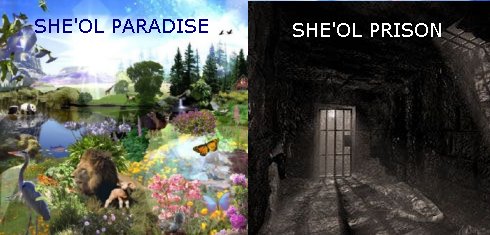
3. TAKH'TI / TARTARÓO / TARTARUS
Resembling the Prison compartment of She'oll, Tartarus is not a place where disembodied dead human are found but is reserved exclusively for the disobedient Watcher malakim (angels) who led the pre-flood rebellion at Mt.Hermon, the apostle Peter graphically describes this place as being like "gloomy dungeons" (2 Pet.2:4, NIV, JNT), "dark dungeons" (S&G), "chains of darkness" (Peshitta, Coverdale, KJV, NKJV, ISRV, OJB, HRV, RSTNE), "pits of darkness" (ASV, NASU, NASB), "pits of dense darkness" (NWT), "chains of gloomy darkness" (ESV), "chains of deepest darkness" (NRSV), "pits of gloom" (AmpV), "pits of [the] nether gloom" (RSV, Moffat), "dark underground caves" (JB) and "gloomy caverns" (CLNT).
As this is the lowest part of She'ol, some assume that its conditions resemble those of the human quarter from which it is separated, from which they deduce that the Prison part for disobedient, sinful humans is not a fiery furnace but a place of complete isolation and gloominess. This does not, however, agree with Yah'shua's (Jesus') insistance in the Parable of Lazarus and Dives that the wicked are in torment of fire.
Why the fallen Watcher malakim (angels) are not similarly described as being in torment is not explained, and may simply be the Tanakh's (Old Testament's) lack of revelation about the details.
The Septuagint (LXX) or authorised Greek translation of the Tanakh (Old Testament) translates the Hebrew takh'ti as tartaróo (Tartarus), from which we get the modern word in our Greek translation of the Messianic Scriptures (New Testament).
As the inmpression is conveyed that the fallen Watcher malakim (angels) are conscious in this, the deepest abyss or lowest section of She'ol, it is a safe bet to assume that the imprisoned humans in the section above it are conscious too. If the fallen malakim (demons) are afraid of Tartarus (Lk.8:31), then we can probably assume that the Prison above is a place to be greately feared too. You do not fear a place where you have no consciousness. So it may very well be that they experience torment of fire like the humans in Prison.
Only one version, the Aramaic English New Testament (AENT), insists that the Aramaic word meaning "fiery regions" should be used of Tartarus. Why this version does so is presently unclear as two other traslators who use the Aramaic Peshitta/Syriac as their primary source insist on "chains of darkness" (Trimm & Magiera) in agreement with the near total scholarly consensus. Messianic Evangelicals therefore see no reason to go with "fiery regions" even though this may be an accurate description of the Watcher Prsion. What is perhaps ironic is that the AENT author (Roth), who is an advocate of soul-sleeping, should ascribe to Tartarus the very pagan imagery of fire and torture (or something like it) that he elsewhere condemns as borrowed from heathenism. It makes no sense that a place should be 'fiery' whilst its occupants are either unconscious or even non-existant.
(Most soul-sleepers do not believe man has a 'spirit' which is his character. Rather, they maintain man consists only of his physical body, which is his essential self, and the 'spirit of God' which returns to Yahweh at death, leaving each individual no more than a memory in the mind of Yahweh from which He will one day recreate, in resurrected form, the 'spirits' of the dead. Messianic Evangelicals have always rejected this non-sensical doctrine).
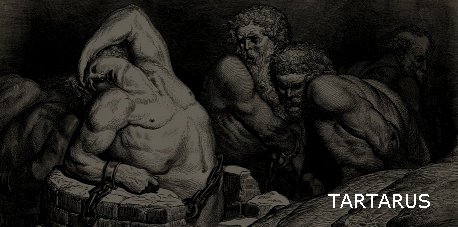
4. GE'HINNOM / GÉENA / GEHENNA
Ge'Hinnom or its Greek form Géena, is known to us mostly in its Latin form, 'Gehenna', and appears 12 times in the Messianic Scriptures (New Testament). Literally, the 'Valley of Gehenna', this is a real place south and south-west of Jerusalem known in the Arabic as Wadi er-Rabâbi. It meets with the Kidron Valley at En-rogel. It gets its name from a family called Hinnom, and was originally known as the "Valley of Ben Hinnom" (Jer.19:2, NIV), "the Son of Hin'nom" (ESV, NRSV, ISRV), "Gey Ben-Hinnom" (OJB) or "..ad vallem filii (sons of) Ennom" (Lat.Vulgate).
The valley became a place of idol worship and child sacrifice during the period of the Monarchy (2 Ki.23:10; Jer.32:35), with the navi (Prophet) Jeremiah proclaiming that the valley would become known as the "valley of slaughter" where Yahweh would judge and punish His people (Jer.7:30-32; 19:2,6). The navi (prophet) Joel likewise had visions of Yahweh's judgment occuring in a valley just outside the city of Jerusalem (Joel 3:2,12,14; Is.30:29-33; 66:24). By the time of the Maccabees, the valley was the appropriate location in which to burn the bodies of one's enemies.
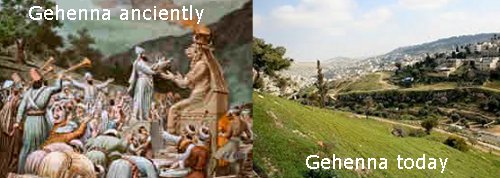
In theory, a Hebrew could not go directly from the Hinnom dump to the temple because of the worshipper's unclean status. This status of being unkosher ('cut-off') and the past association of the valley with a place of judgment combined to create a vivid metaphor for 'hell'.
Aditionally, the altars for pagan worship in the valley of Hinnom at Topheth, where Ba'al was worshipped, involved the funneling of the victim's blood directly into the earth to satisfy the lust of the god (demon) Moloch, which may have some bearing on the enduring belief that this was an entrance to the underworld (the opposite of Jacob's discovery of a staircase to heaven).
1 Enoch, a Pharisaic work, viewed "the accursed valley" of Yahweh's judgment as outside the city of Jerusalem, the centre of the world (e.g. 1 Enoch 27:1).
By New Testament times the idea of 'Gehenna' had acquired a special kind of symbolism shaped by the historical events that preceeded it. From a literal valley outside Jerusalem (as it still was in apostolic times), Gehenna came to be used as a symbollic illustration of an otherworldly place of future punishment for the wicked, thanks in part to the development of the kind of Pharisaic theology which influenced 1 Enoch, and became linked to the 'Prison' compartment of She'ol (Hades).
The valley of Ge'Hinnom was desacralised (to make it unfit for pagan worship) to become a place where trash and the dead bodies of criminals were dumped and burned, where maggots and worms crawled through the waste, and the smoke smelled strong and sickening (Is.30:33). The location thus become 'unclean', access to it being through the 'Gate of the Ash-heaps' at the eastern extremity of the valley at its juncture with the ravine of the Kidron (Neh.3:13-14). For centuries, constant fires burned the refuse deposited there, giving the place a sense of evil permanence. Without a doubt this valley contributed to the various descriptions of 'hell' that we find in the Messianic Scriptures (New Testament) of which Matthew 5:22 is representative. Thus over time the Prison compartment of She'ol (Hades) acquired the appropriate name 'Gehenna':
- "hell fire" (KJV, NKJV),
- "fiery hell" (NASB), or
- "the fire of hell" (NIV)
- literally,
- "the Gehenna of fire" (CLNT),
- "the hell (Gehenna) of fire" (AMpV, ESV),
- "the fiery Gehenna" (NWT),
- "the fire of Gey-Hinnom" (JNT, HRB),
- "the Gey-Hinnom of the fire" (Katta Mattyah),
- "Eish (fire of) Gehinnom" (OJB),
- "the Gehenna of fire" (AENT),
- "Gei-Hinnom fire" (RSTNE), or
- "gehennae ignis" (Lat.Vulgate)
The fires and stench, along with the recollection of the horrors historically practiced there, and the condemnation of those evils by Yahweh's nevi'im (prophets), generated over time the first century AD theological word 'Gehenna', the place of burning torture of condemned people. As we look at later Jewish and Christian religious literature, we get an idea of this theological development:
"Recompense shall follow, and the reward shall be manifested; righteous deeds shall awake, and unrighteous deeds shall not sleep. The pit (Lat. 'place') of torment shall appear, and opposite it shall be the place of rest; and the furnace of hell (Gehenna) shall be disclosed, and opposite it the paradise of delight" (Apocrypha, 2 Esdras 7:35-36, NRSV)
2 Esdras 3-14 (4 Ezra) is a non-canonical Jewish pseudepigraphic apocalpyse, written in Hebrew and then translated into Greek (though the primary version is in Latin), that reflects the historical conditions and theological concerns arising from the destruction of Jerusalem and its Temple in 30 AD. Most interpreters read the work against a backdrop of events in the mid- and late 3rd century AD Roman Empire though it likely reflects the belief about Gehenna from an earlier time. Dante simply embellished on the earlier belief to make it more graphically horrible.
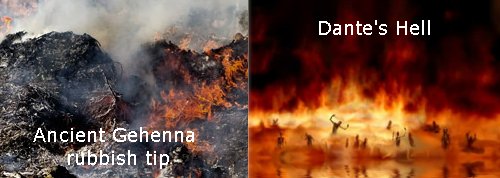
In order to properly understand what the valley symbolism refers to in the Messianic Scriptures, it is important to underline that 'Gehenna' does not equate with She'ol/Hades or Tartarus (which are temporary holding places for the dead between the Fall and the Second Coming of Messiah) but with the state of the wicked after the Final Judgment. Thus, though the conditions for the wicked are almost certainly the same, Ge'Hinnom/Gehenna specifically refers to She'ol's Prison after the Second Coming and the Final Judgment.
The failure to make the critical distinction between She'ol and Gehenna is what has led to all the confusion about 'hell' over the centuries. The ecclesiastical 'menu' basically offers two exegetical solutions, neither of which we, as Messianic Evangelicals, believe are wholly correct:
- 1. The traditional Catholic-Protestant belief, embellished by Dante and Greek Paganism, views 'hell' as a place of eternal torture, without end, for the unsaved wicked; and
- 2. The 'Soul-Sleeping' view, of which the Jehovah's Witnesses are the most numerous advocates, which views the dead (both the good and evil - the saved and unsaved) as either being unconscious or having no existence at all - soul-sleepers deny that a fiery place of torment even exists, viewing it as purly symbolic or the invention of Greek pagans. In other words, those who advocate soul-sleeping, when confronted with the very clear explanation of the Messianic Scriptures (New Testament), tend (like the Jehovah's Witnesses) to press for the the idea that the language describing activity in She'ol, Tartarus and Ge'Hinnom is purely symbolic and not describing places inhabited by conscious beings. Many soul-sleepers believe that the wicked, after they have been resurrected, are annihilated.
Messianic Evangelicals have a third position. We totally reject the soul-sleeping doctrine as unscriptural and regard the traditional Catholic-Protestant view of hell as a semi-pagan relic of mediaeval theology containing some truth. This will now be explained more fully.
The Different Kinds of Resurrection
An accurate biblical theology of 'hell' first of all requires a proper understanding of resurrection which must be viewed from two angles:
- 1. The two-stage timing of various resurrections types; and
- 2. The three different types of resurrection.
There are two resurrections as pertaining to timing:
- 1. The First Resurrection which takes place when Yah'shua (Jesus) returns - the resurrection of the Bride, those faithful, submitted and Torah-obedient (commandment-keeping) believers, both those alive when He comes and those dead in the 'Paradise' section of She'ol/Hades awaiting His return. This Remnant is compartively small in number but will repopulate the Millennial earth, their mortal offspring living to a very great age - the latter will be tested and judged when Satan and his demons are released one last time at the end of the Millennium;
- 2. The Second Resurrection which occurs after the 1,000 year-long Millennium on earth is completed, consisting of the disobedient believers (more numerous that those of the First Resurrection) and all the unsaved wicked (even more numerous than the disobedient believers).
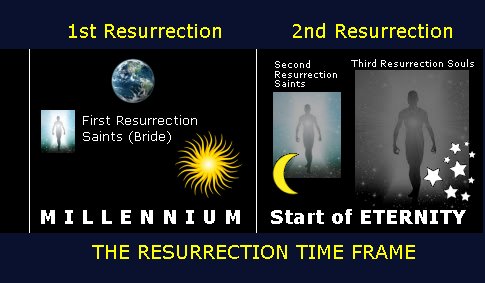
There are three categories of resurrection as pertaining to glory, that is, quality:
- 1. The First Resurrection qodeshim (saints, set-apart ones) - the obedient, submitted Bride who inherit a post-Millennium glorfied earth which is likened by Paul to the brightness of the sun in glory, which is their eternal, transformed home and which shall form after all the elements have melted and a new world emerges. Those living on the resurrected earth live in the presence of Elohim (God) forever;
- 2. The Second Resurrection qodeshim (saints, set-apart ones) - the disobedient, not fully submitted believers who if alive at the Second Coming, perish and join their fellows as disembodied spirits in the Paradise portion of She'ol (now emptied of First Resurrection believers). They must remain in She'ol (as 'dead' beings) until the end of the Millennium whence they will inherit an unnamed resurrection world likened by Paul to the brightness or glory of the moon, which is their eternal home. Conceivably, this is a glorified moon rendered habitable. These do not live in the presence of Yahweh-Elohim but have access to Him indirectly through First Resurrection human agents and faithful malakim (angels); and
- 3. The Third Resurrection souls - the disobedient, rebellious and unsubmitted men and women who refused to accept Yah'shua (Jesus) as their Messiah and therefore receive no regeneration, who all perish at the Second Coming (if alive then) and join their fellow unsaved in the Prison section of She'ol, the place of fiery torment. This Prison portion is also called Gehenna where they will be punished, first as disembodied spirits, then as resurrected beings as members of the "resurrection of condemnation" (Jn.5:29, NKJV) at the end of the Millennium, by their own seared consciences and guilt which will seem to them like a never ending fire of torment as they realise what they have done and knowing that there is no possible redemption for them because all chosing for Yah'shua (Jesus) or Satan is permanently over. What they do not know, and what most believers still do not know, is that there is a pardon in the distant future at the Cosmic Jubilee. This punishment will almost certainly continue way past the duration of the Millennium (or will otherwise appear to some) after which they will inherit an inferior resurrection glory, receiving their resurrection bodies at the end of, or beyond, the Millennium. This resurrection glory cannot remotely compare to the glory of the First and Second Resurrection souls, being pale by comparison, which Paul likens to the glory of the stars.
Thus all are in the end saved but not all inherit the same glory or rewards. This Messianic Evangelicals call Universal Graded Salvation, the doctrine that reveals the fullness of both Yahweh's grace (underserved loving kindness, unmerited favour) and His justice. This is not the same as what some call 'Universal Salvation', a liberal variety which falsely teaches that everybody goes to (or inherits) the same 'Heaven' and glory - both the obedient saved and the disobedient saved, and the unsaved wicked - because of Yahweh's 'grace', and fundamentally denies Yahweh's justice. How everything pans out in eternity-distant is unknown.

What is Eternity?
The English word 'eternity', like 'hell', can be misleading when applied to biblical theology. Without a doubt, Elohim (God) is 'eternal', since He has neither beginning nor ending. Yah'shua the Messiah (Jesus Christ) is described as the "the Alpha and the Omega, the First and the Last, the Beginning and the End" (Rev.22:13, NIV) or in the original Hebrew, "the Alef and the Taw", the first and last letters of the Greek and Hebrew alphabets, respectively, indicating His eternal nature. No being or thing is therefore 'eternal' except they be in Elohim (God) by emunah (faith) and walking in obedience in divine tavnith (pattern). Eternity, therefore, exists only where Elohim (God) sustains, permanently in His presence or temporarily beyond it. The earth and all the fallen universe is only temporarily sustained, and is not therefore permanent or eternal. We, as human beings, may therefore be said to be 'conditionally immortal'. Outside of Yahweh, we are given no guarantee of immortality.
The word 'eternity' translates two different concepts in our English Bibles:
- 1. Age-long (a dispensation, eon or aeon); and
- 2. Never-ending.
The first may, because it is so long, seem like 'eternity' but is not. The Hebrew language lends itself to much hyperbole (exaggeration), like English and every other language. Thus when we say, 'I've been waiting for ever!' everyone knows that the duration is a fixed one but appears to be 'for ever'. For example:
"And Yahweh spoke to Moses, saying, 'This is the offering of Aaron and his sons, which they shall offer to Yahweh, beginning on the day when he is anointed: one-tenth of an ephah of fine flour as a daily grain offering, half of it in the morning and half of it at night. It shall be made in a pan with oil. When it is mixed, you shall bring it in. The baked pieces of the grain offering you shall offer for a sweet aroma to Yahweh. The cohen (priest) from among his sons, who is anointed in his place, shall offer it. It is a statute forever to Yahweh" (Lev.6:19-22, NKJV).
Now the Aaronic or Levitical Priesthood has since passed away and believers are under the Melchizedek Priesthood which is truly a 'forever' Priesthood:
"Yahweh hath sworn, and will not repent, Thou art a cohen (priest) for ever after the order of Melchizedek" (Ps.110:4, KJV).
How is this possible? Because Yah'shua (Jesus) is our Cohen Gadol (High Priest) and, being Elohim (God), is by definition "for ever" or eternal. The Levitical Priesthood has, according to the Book of Hebrews, passed away. Therefore the "forever" is not referring to eternity but to a dispensation - the aeon, era or period assigned by Yahweh to the Mosaic Covenant.
References to She'ol, Hades, Tartarus or Gehenna as being 'forever', must therefore be understood in terms of dispensations. You will find articles explaining this more fully below.
What is Hell-Fire?
What exactly is hell-fire, who is it for, and what does it do? The wisdom of orthodox Christianity is that it is the mode of punishment ordered by Yahweh and executed (for the most part) by tormenting demons (who do so with relish). Without a doubt, those who reject the covering of Yah'shua the Messiah (Jesus Christ) expose themselves to the 'mercies' of demons. They get what they asked for though perhaps not in the way they expected.
Consistenly throughout Scripture the Fire of Yahweh is to be properly seen not as directly punitive but as remedial and purifying. The 'punishment' comes in refusing the free pardon and cleansing of Yah'shua (Jesus) through emunah (faith) and repentance, for refusal implies that man must atone for his own sins, which is impossible. All souls must pass through Yahweh's Fire but this fire does not hurt those who are in Yah'shua (Jesus), in the same way a fireman is protected from the flames by a fire-proof suit. The wicked have no such protection or covering, their sins condemning them as they view the horror of being in the midst of such purity whilst being unclean. This is their torment. Just as a fireman without a fire-proof suit is 'tormented' by fire, so those who have not 'put on Messiah' on the conditions He has given must be tormented by the agonising purifying Fire of the Almighty.
Even disobedient believers must have their sin burned out of them because there is no more choosing after death:
"For no one can lay any foundation other than the one already laid, which is Yah'shua the Messiah (Jesus Christ). If any man builds on this foundation using gold, silver, costly stones, wood, hay or straw, his work will be shown for what it is, because the Day [of Yahweh/the LORD - Judgment Day) will bring it to light. It will be revealed with fire, and the fire will test the quality of each man's work. If what he has built survives, he will receive his reward. If it is burned up, he will suffer loss; he himself will be saved, but only as one escaping through the flames" (1 Cor.3:11-15, NIV).
To a large extent, this "testing" occurs in mortality too which is why we are sometimes permitted to go through considerable difficulities and hardships. It then becomes our opportunity to repent, while we are still alive, before the opportunity is denied after death. How, where and when this happens to the disobedient disembodied spirits of believers is not explained in Scripture but one possibility is they do so during the Millennium in She'ol.
The Catholic doctrine of Purgatory, formulated at the Councils of Florence and Trent (14th & 15th centuries), may in part have arisen to explain this passage, but goes one stage further (and beyond what the Scriptures say) in claiming that those disobedient believers, thus purged, become entitled to the same rewards as those believers who required no such purging, thus blurring the very clear distinction between the First and Second Resurrections.
For a fuller understanding of 'hell-fire', see the three-part series, The Fire of Yahweh.
The Good News is that Yahweh, in His mercy, will proclaim, at some distant point in time, a Cosmic Jubilee, bringing these torments to a permanent end and enabling these tortured souls to inherit a pale glory akin in brightness to the stars. They will be grateful for it, knowing that they surely deserved their punishment forever, and that only the long-suffering and grace of Yahweh finally delivered them. Only then will Yahweh be satisfied. They will not question His justice, any more than Dives (the rich man) did in Yah'shua's (Jesus') parable. To those suffering it, it will appear to be eternally long. This doctrine of Universal Graded Salvation should in no way be used as an excuse to indulge in sin. No one wants to go through the Fire of Yahweh without the covering of Messiah for this will be experientially and existentially every man's worst nightmare of HELL, only worse.
Summary of the Nature of the Holding Station for the Dead
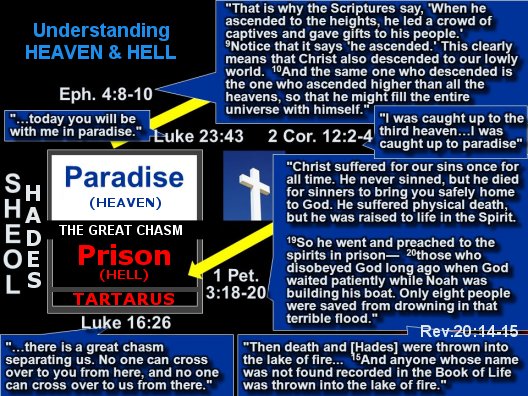
For more in-depth articles on hell, see the directory below. (26 October 2017)
|


